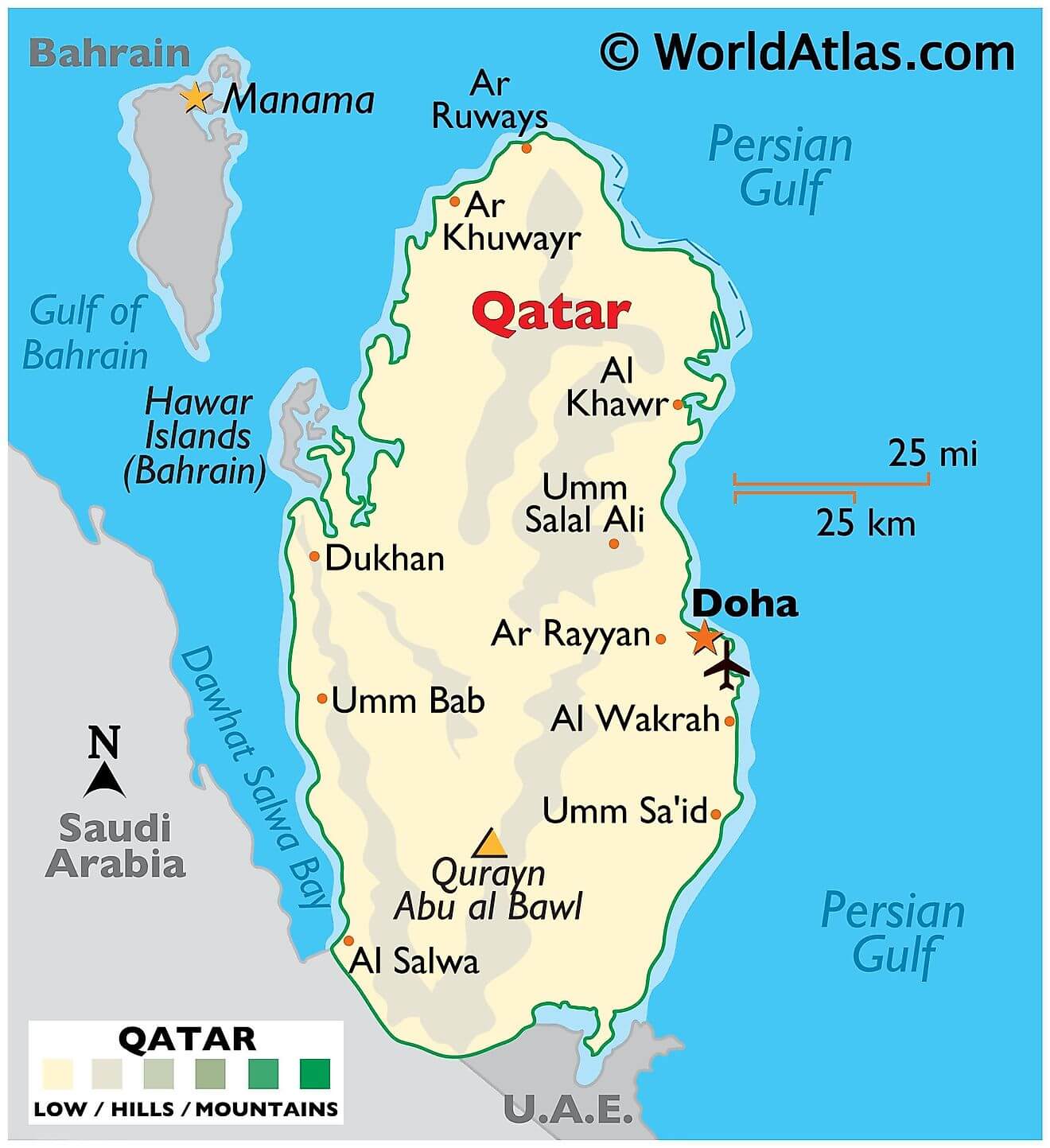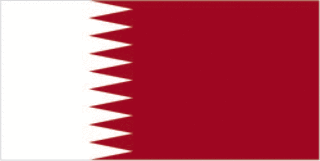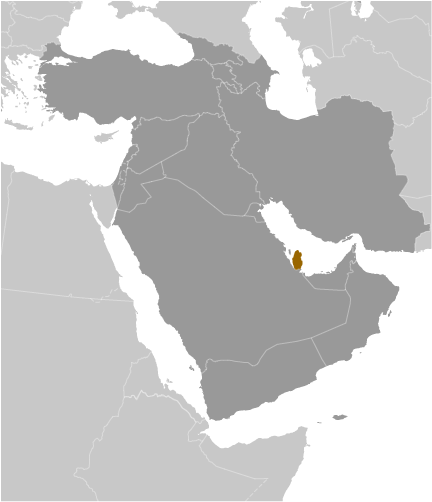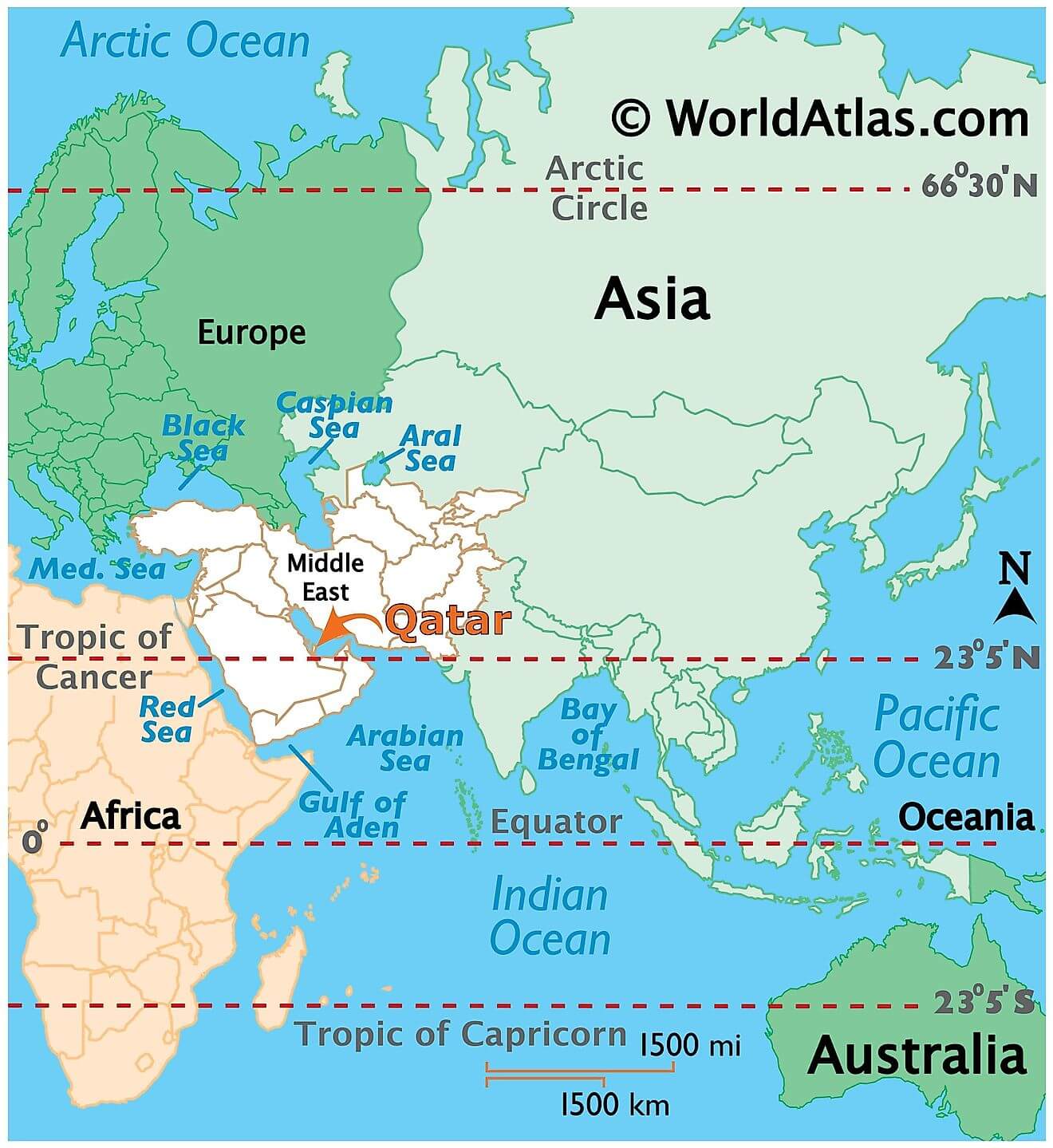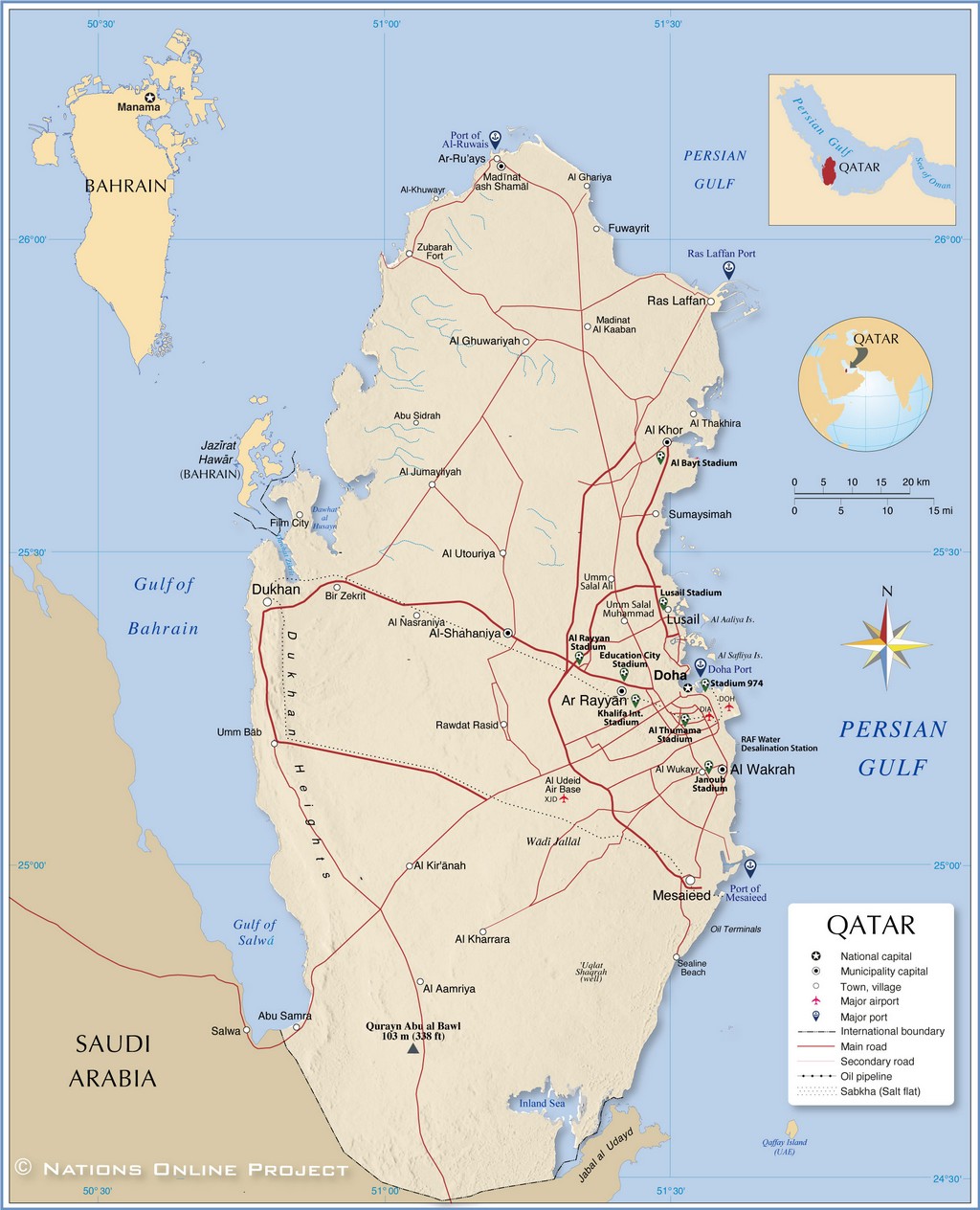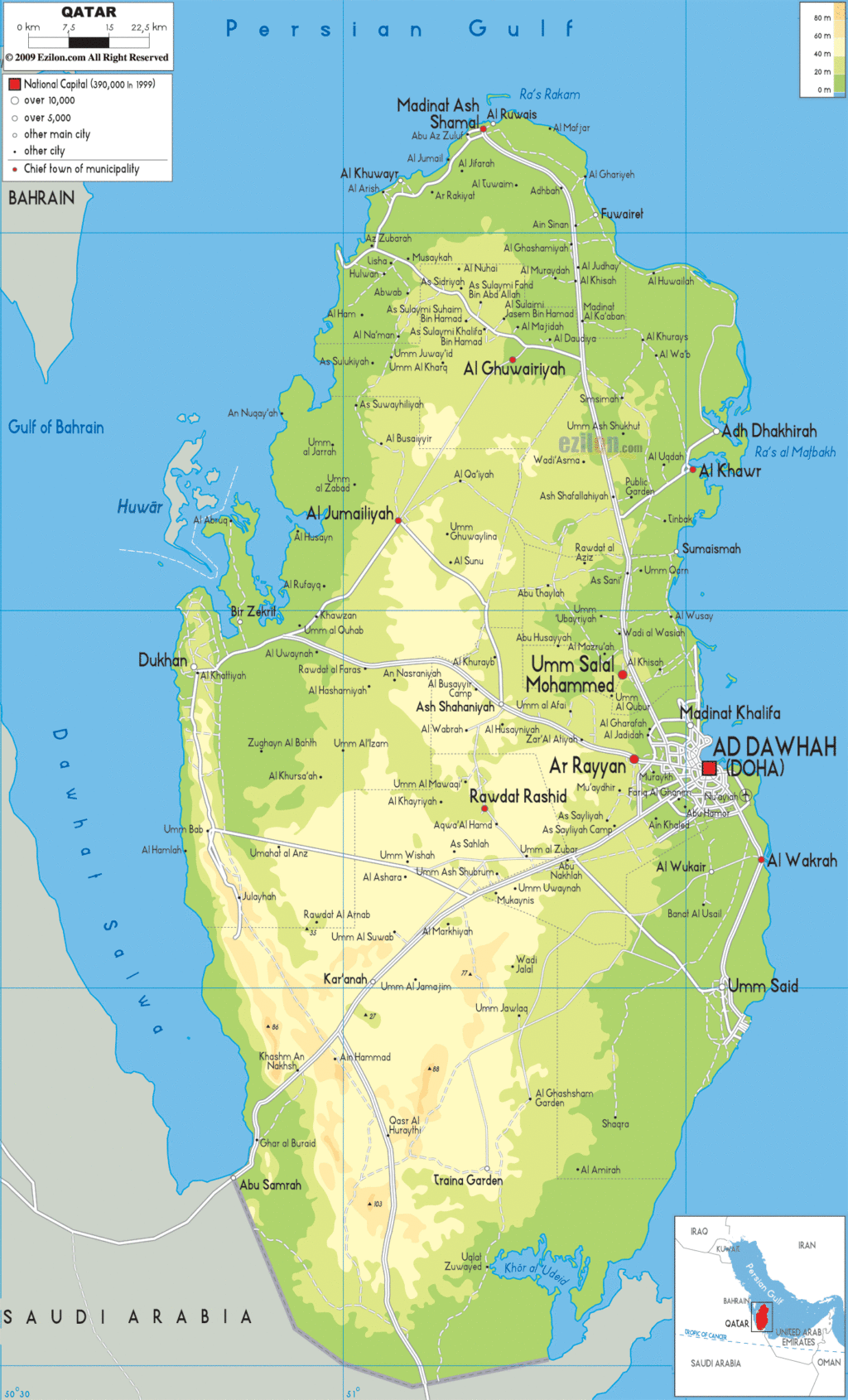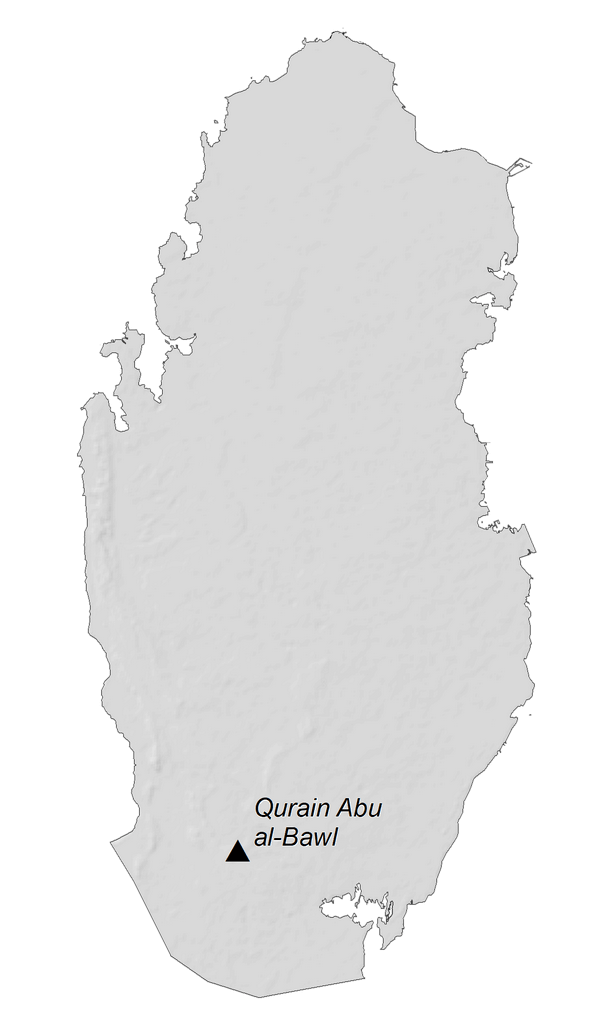As observed on the physical map of Qatar, the country occupies a peninsula extending into the Persian Gulf from the Arabian Peninsula. The country also has several low lying offshore islands. Qatar occupies a total area of 11,437 sq. km.
The highly flat nature of Qatar’s terrain is easily visible on the map. The highest point in the country is Qurain Abu al-Bawl that is only 103 m (338 ft)) and rocky. It has been marked on the map by a yellow upright triangle.
Notable features include coastal salt pans, elevated limestone formations (the Dukhan anticline) along the west coast under which lies the Dukhan oil field, and massive sand dunes surrounding Khawr al Udayd, an inlet of the Persian Gulf in the southeast known to local English speakers as the Inland Sea.
Qatar is an incredible country, boasting vibrant cities, vast deserts, and a unique culture. With this map, you can explore the geography of Qatar in detail, from its major cities to its highways and populated places. The satellite view gives you a stunning overview of the country’s deserts, while the elevation map shows its highest and lowest points. Whether you’re a traveler or an armchair explorer, this map of Qatar is the perfect way to explore the country from the comfort of your own home.
Online Interactive Political Map
Click on ![]() to view map in "full screen" mode.
to view map in "full screen" mode.
Qatar (officially, the state of Qatar) is divided into 8 municipalities. In alphabetical order, these municipalities are: Al-Daayen, Al-Khawr, Al-Rayyan, Al-Shahaniya, Al-Shamal, Al-Wakrah, Doha and Umm Salal Muhammad. These municipalities are further subdivided into 98 zones and smaller subdivisions.
With an area of 3,309.0 sq. km, Al-Shahaniya is the largest municipality by area while Al-Daayen is the most populous one.
Doha is the capital and largest city of Qatar. Doha is located in the eastern part of the country, on the coasts of the Persian Gulf. It is the most populous city and also the country’s political and economic center.
Location Maps
Where is Qatar?
Qatar is a small peninsula in the Middle East, located along the coast of the Persian Gulf. It borders only one country, Saudi Arabia, to the southwest, and is close to Bahrain and the United Arab Emirates to the northwest and southeast, respectively. Qatar’s peninsula, known as the Qatari Peninsula, is home to the islands of Pearl-Qatar, Al Safliya, and Al Aaliya. The capital and largest city of Qatar, Doha, is situated along the Persian Gulf to the east.
Qatar’s strategic location makes it a hub for oil and natural gas deposits and exchanges. This has consequently made petroleum resources a major economic engine and source of employment in the country.
High Definition Political Map of Qatar

History
Antiquity
Human habitation in Qatar dates back to 50,000 years ago. Settlements and tools dating back to the Stone Age have been unearthed in the peninsula. Mesopotamian artifacts originating from the Ubaid period (c. 6500–3800 BC) have been discovered in abandoned coastal settlements. Al Da’asa, a settlement located on the western coast of Qatar, is the most important Ubaid site in the country and is believed to have accommodated a small seasonal encampment.
Kassite Babylonian material dating back to the second millennium BC found in Al Khor Islands attests to trade relations between the inhabitants of Qatar and the Kassites in modern-day Bahrain. Among the findings were 3,000,000 crushed snail shells and Kassite potsherds. It has been suggested that Qatar is the earliest known site of shellfish dye production, owing to a Kassite purple dye industry which existed on the coast.
In 224 AD, the Sasanian Empire gained control over the territories surrounding the Persian Gulf. Qatar played a role in the commercial activity of the Sasanids, contributing at least two commodities: precious pearls and purple dye. Under the Sasanid reign, many of the inhabitants in Eastern Arabia were introduced to Christianity following the eastward dispersal of the religion by Mesopotamian Christians. Monasteries were constructed and further settlements were founded during this era. During the latter part of the Christian era, Qatar comprised a region known as ‘Beth Qatraye’ (Syriac for “house of the Qataris”). The region was not limited to Qatar; it also included Bahrain, Tarout Island, Al-Khatt, and Al-Hasa.
In 628, the Islamic prophet Muhammad sent a Muslim envoy to a ruler in Eastern Arabia named Munzir ibn Sawa Al Tamimi and requested that he and his subjects accept Islam. Munzir obliged his request, and accordingly, most of the Arab tribes in the region converted to Islam. In the middle of the century, the Muslim conquest of Persia would result in the fall of the Sasanian Empire.
Early and late Islamic period (661–1783)
Qatar was described as a famous horse and camel breeding centre during the Umayyad period. In the 8th century, it started benefiting from its commercially strategic position in the Persian Gulf and went on to become a centre of pearl trading.
Substantial development in the pearling industry around the Qatari Peninsula occurred during the Abbasid era. Ships voyaging from Basra to India and China would make stops in Qatar’s ports during this period. Chinese porcelain, West African coins, and artefacts from Thailand have been discovered in Qatar. Archaeological remains from the 9th century suggest that Qatar’s inhabitants used greater wealth to construct higher quality homes and public buildings. Over 100 stone-built houses, two mosques, and an Abbasid fort were constructed in Murwab during this period. When the caliphate’s prosperity declined in Iraq, so too did it in Qatar. Qatar is mentioned in 13th-century Muslim scholar Yaqut al-Hamawi’s book, Mu’jam Al-Buldan, which alludes to the Qataris’ fine striped woven cloaks and their skills in improvement and finishing of spears.
Much of Eastern Arabia was controlled by the Usfurids in 1253, but control of the region was seized by the prince of Ormus in 1320. Qatar’s pearls provided the kingdom with one of its main sources of income. In 1515, Manuel I of Portugal vassalised the Kingdom of Ormus. Portugal went on to seize a significant portion of Eastern Arabia in 1521. In 1550, the inhabitants of Al-Hasa voluntarily submitted to the rule of the Ottomans, preferring them to the Portuguese. Having retained a negligible military presence in the area, the Ottomans were expelled by the Bani Khalid tribe and their emirate in 1670.
Bahraini and Saudi rule (1783–1868)
In 1766, members of the Al Khalifa family of the Utub tribal confederation migrated from Kuwait to Zubarah in Qatar. By the time of their arrival, the Bani Khalid exercised weak authority over the peninsula, notwithstanding the fact that the largest village was ruled by their distant kin. In 1783, Qatar-based Bani Utbah clans and allied Arab tribes invaded and annexed Bahrain from the Persians. The Al Khalifa imposed their authority over Bahrain and retained their jurisdiction over Zubarah.
Following his swearing-in as crown prince of the Wahhabi in 1788, Saud ibn Abd al-Aziz moved to expand Wahhabi territory eastward towards the Persian Gulf and Qatar. After defeating the Bani Khalid in 1795, the Wahhabi were attacked on two fronts. The Ottomans and Egyptians assaulted the western front, while the Al Khalifa in Bahrain and the Omanis launched an attack against the eastern front. Upon being made aware of the Egyptian advance on the western frontier in 1811, the Wahhabi amir reduced his garrisons in Bahrain and Zubarah in order to redeploy his troops. Said bin Sultan, ruler of Muscat, capitalised on this opportunity and raided the Wahhabi garrisons on the eastern coast, setting fire to the fort in Zubarah. The Al Khalifa was effectively returned to power thereafter.
As punishment for piracy, an East India Company vessel bombarded Doha in 1821, destroying the town and forcing hundreds of residents to flee. In 1825, the House of Thani was established with Sheikh Mohammed bin Thani as the first leader.
Although Qatar was considered a dependency of Bahrain, the Al Khalifa faced opposition from the local tribes. In 1867, the Al Khalifa, along with the ruler of Abu Dhabi, sent a massive naval force to Al Wakrah in an effort to crush the Qatari rebels. This resulted in the maritime Qatari–Bahraini War of 1867–1868, in which Bahraini and Abu Dhabi forces sacked and looted Doha and Al Wakrah. The Bahraini hostilities were in violation of the Perpetual Truce of Peace and Friendship of 1861. The joint incursion, in addition to the Qatari counter-attack, prompted British Political Resident, Colonel Lewis Pelly to impose a settlement in 1868. His mission to Bahrain and Qatar and the resulting peace treaty were milestones because they implicitly recognised the distinctness of Qatar from Bahrain and explicitly acknowledged the position of Mohammed bin Thani. In addition to censuring Bahrain for its breach of agreement, Pelly negotiated with Qatari sheikhs, who were represented by Mohammed bin Thani. The negotiations were the first stage in the development of Qatar as a sheikhdom. However, Qatar was not officially recognised as a British protectorate until 1916.
The Ottoman period (1871–1915)
Under military and political pressure from the governor of the Ottoman Vilayet of Baghdad, Midhat Pasha, the ruling Al Thani tribe submitted to Ottoman rule in 1871. The Ottoman government imposed reformist (Tanzimat) measures concerning taxation and land registration to fully integrate these areas into the empire. Despite the disapproval of local tribes, Al Thani continued supporting the Ottoman rule. Qatari-Ottoman relations, however, soon stagnated, and in 1882 they suffered further setbacks when the Ottomans refused to aid Al Thani in his expedition of Abu Dhabi-occupied Khawr al Udayd. In addition, the Ottomans supported the Ottoman subject Mohammed bin Abdul Wahab who attempted to supplant Al Thani as kaymakam of Qatar in 1888. This eventually led Al Thani to rebel against the Ottomans, whom he believed were seeking to usurp control of the peninsula. He resigned as kaymakam and stopped paying taxes in August 1892.
In February 1893, Mehmed Hafiz Pasha arrived in Qatar in the interests of seeking unpaid taxes and accosting Jassim bin Mohammed’s opposition to proposed Ottoman administrative reforms. Fearing that he would face death or imprisonment, Jassim retreated to Al Wajbah (16 km or 10 mi west of Doha), accompanied by several tribe members. Mehmed’s demand that Jassim disbands his troops and pledge his loyalty to the Ottomans was met with refusal. In March, Mehmed imprisoned Jassim’s brother and 13 prominent Qatari tribal leaders on the Ottoman corvette Merrikh as punishment for his insubordination. After Mehmed declined an offer to release the captives for a fee of 10,000 liras, he ordered a column of approximately 200 troops to advance towards Jassim’s Al Wajbah Fort under the command of Yusuf Effendi, thus signalling the start of the Battle of Al Wajbah.
Effendi’s troops came under heavy gunfire by a sizable troop of Qatari infantry and cavalry shortly after arriving at Al Wajbah. They retreated to Shebaka fortress, where they were again forced to draw back from a Qatari incursion. After they withdrew to Al Bidda fortress, Jassim’s advancing column besieged the fortress, resulting in the Ottomans’ concession of defeat and agreement to relinquish their captives in return for the safe passage of Mehmed Pasha’s cavalry to Hofuf by land. Although Qatar did not gain full independence from the Ottoman Empire, the result of the battle forced a treaty that would later form the basis of Qatar’s emerging as an autonomous country within the empire.
British period (1916–1971)
By the Anglo-Turkish Convention of 1913, the Ottomans agreed to renounce their claim to Qatar and withdraw their garrison from Doha. However, with the outbreak of World War I, nothing was done to carry this out and the garrison remained in the fort at Doha, although its numbers dwindled as men deserted. In 1915, with the presence of British gunboats in the harbour, Abdullah bin Jassim Al Thani (who was pro-British) persuaded the remainder to abandon the fort and, when British troops approached the following morning, they found it deserted.
Qatar became a British protectorate on 3 November 1916, when the United Kingdom signed a treaty with Sheikh Abdullah bin Jassim Al Thani to bring Qatar under its Trucial System of Administration. While Abdullah agreed not to enter into any relations with any other power without the prior consent of the British government, the latter guaranteed the protection of Qatar from aggression by sea and provide its ‘good offices’ in the event of an attack by land – this latter undertaking was left deliberately vague. On 5 May 1935, while agreeing an oil concession with the British oil company, the Anglo-Persian Oil Company, Abdullah signed another treaty with the British government which granted Qatar protection against internal and external threats. Oil reserves were first discovered in 1939. Exploitation and development were, however, delayed by World War II.
The focus of British interests in Qatar changed after the Second World War with the independence of India, the creation of Pakistan in 1947, and the development of oil in Qatar. In 1949, the appointment of the first British political officer in Doha, John Wilton, signified a strengthening of Anglo-Qatari relations. Oil exports began in 1949, and oil revenues became the country’s main source of revenue, the pearl trade has gone into decline. These revenues were used to fund the expansion and modernisation of Qatar’s infrastructure. When Britain officially announced in 1968 that it would withdraw from the Persian Gulf in three years’ time, Qatar joined talks with Bahrain and seven other Trucial States to create a federation. Regional disputes, however, persuaded Qatar and Bahrain to withdraw from the talks and become independent states separate from the Trucial States, which went on to become the United Arab Emirates.
Independence and later (1971–2000)
On 3 November 1916, the sheikh of Qatar entered into treaty relations with the United Kingdom. The treaty reserved foreign affairs and defence to the United Kingdom but allowed internal autonomy. On 3 September 1971, those “special treaty arrangements” that were “inconsistent with full international responsibility as a sovereign and independent state” were terminated. This was done under an agreement reached between the Ruler of Qatar and the Government of the United Kingdom.
In 1991, Qatar played a significant role in the Gulf War, particularly during the Battle of Khafji in which Qatari tanks rolled through the streets of the town and provided fire support for Saudi Arabian National Guard units that were engaging Iraqi Army troops. Qatar allowed coalition troops from Canada to use the country as an airbase to launch aircraft on CAP duty and also permitted air forces from the United States and France to operate in its territories.
In 1995, Emir Hamad bin Khalifa Al Thani seized control of the country from his father Khalifa bin Hamad Al Thani, with the support of the armed forces and cabinet, as well as neighbouring states and France. Under Emir Hamad, Qatar experienced a moderate degree of liberalisation, including the launch of the Al Jazeera television station (1996), the endorsement of women’s suffrage or right to vote in municipal elections (1999), drafting its first written constitution (2005) and inauguration of a Roman Catholic church (2008).
21st century
Qatar’s economy and status as a regional power rapidly grew in the 2000s. According to the UN, the nation’s economic growth, measured by GDP, was the fastest in the world during this decade. The basis of this growth lies in the exploitation of natural gas in the North Field during the 1990s. Concurrently, the population of Qatar tripled between 2001 and 2011, mostly due to an influx of foreigners.
In 2003, Qatar served as the US Central Command headquarters and one of the main launching sites of the invasion of Iraq. In March 2005, a suicide bombing killed a British teacher from Dorset called Jonathan Adams at the Doha Players Theatre, shocking the country, which had not previously experienced acts of terrorism. The bombing was carried out by Omar Ahmed Abdullah Ali, an Egyptian resident in Qatar who had suspected ties to Al-Qaeda in the Arabian Peninsula.
In 2010, Qatar won the right to host the 2022 FIFA World Cup, making it the first country in the Middle East to be selected to host the tournament. The awarding increased further investment and developments within the nation during the 2010s.
In June 2013, Sheikh Tamim bin Hamad Al Thani became the Emir of Qatar after his father handed over power in a televised speech. Sheikh Tamim has prioritised improving the domestic welfare of citizens, which includes establishing advanced healthcare and education systems, and expanding the country’s infrastructure in preparation for the hosting of the 2022 World Cup.
The Emir announced Qatar’s plans to hold its first national legislative elections in 2013. They were scheduled to be held in the second half of 2013 but were postponed until October 2021. The legislative council hosted the 140th Inter-Parliamentary Union Assembly for the first time in April 2019.
The increased influence of Qatar and its role during the Arab Spring, especially during the Bahraini uprising in 2011, worsened longstanding tensions with Saudi Arabia, the neighboring United Arab Emirates (UAE), and Bahrain. In June 2017, Egypt, Saudi Arabia, United Arab Emirates, and Bahrain cut off diplomatic relations with Qatar, citing the country’s alleged support of groups they considered to be extremist. This has resulted in increased Qatari economic and military ties with Turkey and Iran.
Qatar hosted the 2022 FIFA World Cup from 21 November to 18 December, becoming the first Arab and Muslim-majority country to do so, and the third Asian country to host it following the 2002 FIFA World Cup in Japan and South Korea.
Physical Map of Qatar
